Did you know the curious history of spooky Spain? Learn all about the origins of Halloween’s Celtic origins.
Though most souls associate Halloween with glowing jack o’ lanterns and slasher films, the true origins of this haunting holiday are not rooted in America but go farther back to the Celtic tradition.
READ MORE: These are the ten most haunted houses around Spain
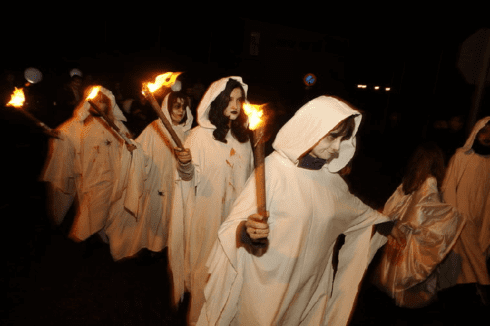 LOOK IF YOU DARE: the traditional procession of the dead, or Santa Compaña
LOOK IF YOU DARE: the traditional procession of the dead, or Santa CompañaPhoto: Tour Galicia
In fact, the eerie roots of Spanish Halloween can be traced back to Galicia, where ancient Celtic rituals still echo through the mists to this day.
Samhain, an ancient Irish festival, was brought to the Iberian Peninsula by the Celts thousands of years ago.
Meaning ‘end of summer,’ Samhain marks the beginning of the Celtic New Year, plunging the world into a shadowy ‘dark period’ that only lifts with the arrival of spring. It is a time when the veil between the living and the dead grows thin, and the spirits of the departed are said to roam freely.
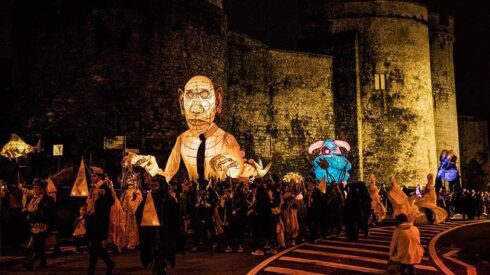 CELTIC: The festival has Irish origins and is still celebrated every spooky season
CELTIC: The festival has Irish origins and is still celebrated every spooky seasonPhoto: Limerick.ie
On November 1, these old traditions come alive in Spain’s northern regions, marked by rituals that stir the souls of those long passed. Long ago, the druid or village leader would summon the gathering, often held in the heart of dark forests where the flickering light of a roaring fire kept the lurking shadows at bay.
Many of these spooky customs would be familiar to Brits from their childhoods, including the time-honoured practice of apple bobbing. And those Halloween costumes we know so well? They originated from the Celtic practice of wearing grotesque masks to confuse and ward off lurking evil spirits.
Meanwhile, the carved pumpkins – once far more sinister- were said to be fashioned from the skulls of fallen enemies, with a flickering candle inside to frighten away mischievous ghosts. Turnips, too, were hollowed out and lit to guide wandering spirits through the mortal realm.
One of the most ghostly Galician rituals is Santa Compaña, a nightmarish procession of the dead. Draped in white and clutching candles, these restless spirits walk solemnly through the town, led by an unfortunate living soul. Dare to peer out of your window during the procession, and legend says you may be cursed to join them in death.
READ MORE: Spooky! How Halloween is celebrated in different parts of Spain
 DEATH MARCH: Santa Compaña is led by an unfortunate soul who was caught spying during the last year’s festivities.
DEATH MARCH: Santa Compaña is led by an unfortunate soul who was caught spying during the last year’s festivities.But beware, for the procession’s leader may very well be the last unlucky soul who spied on them the year before. During Samhain, if someone enters your home, fate may cast its lot – a visit from a troll spells doom, while a fairy’s presence brings blessings.
Even the tradition of ‘trick or treating’, so often cursed as an ‘American invention’, has roots in these ancient Celtic customs.
On the ghostly night of October 31, Celts would knock on doors, asking for offerings of food to honour their dead. Similarly, on November 2, in Illa de Arousa (Galicia), children go door to door begging for sweets – sound familiar?
Celtic traditions are not confined to Galicia alone. In Asturias, they hold banquets in graveyards on Samhain, feasting with the dead, much like the colourful celebrations of the Mexican Dia de los Muertos. Pumpkins are once again a symbol of death, and in the Galician city of Lugo, dried pumpkins are even used as macabre masks during February’s carnival.
“In Galicia, we are resurrecting Samhain to fend off the creeping influence of American Halloween,” said the Galician Tourism Office.
“Across the region, you’ll find rituals such as carving pumpkins, leaving the dinner table set after All Hallows’ Eve so that the dead may dine, and lighting bonfires to guide wandering spirits.”
READ MORE: REVEALED: Top five scariest Spanish films to watch this Halloween
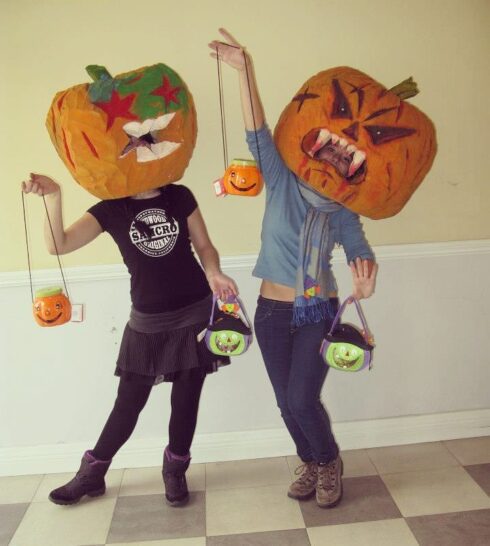 KNIVES OUT: Pumpkin carving is an integral part of Halloween traditions across the world.
KNIVES OUT: Pumpkin carving is an integral part of Halloween traditions across the world. Photo: Amigos de Samain
These bonfires are said to keep visiting spirits warm and to purify the town, driving away any malicious forces. They also play a key role in magostos,or chestnut parties, where townsfolk gather around the fire, sipping wine and feasting on roasted chestnuts to celebrate the harvest.
 PARTY: A magosto being held in Galicia in 1981.
PARTY: A magosto being held in Galicia in 1981.The modern revival of Samhain in Galicia was sparked by a local teacher, Rafael Lopez Loureiro.
In 1990, when his daughter came home with a pumpkin, it stirred ancient memories of his own childhood, and he set out to revive the tradition. After 13 long years of research, he published his study, Samhain: The Pumpkin Festival.
To revive the tradition, Loureiro reintroduced a pumpkin carving contest in his hometown of Cedeira nearly 30 years ago. Today, thanks to the tireless efforts of Loureiro and the Amigos de Samain, Samhain is celebrated in many Galician towns, including Briz, Allariz, Ferrol, A Coruña, Pontevedra, and Ribadavia.
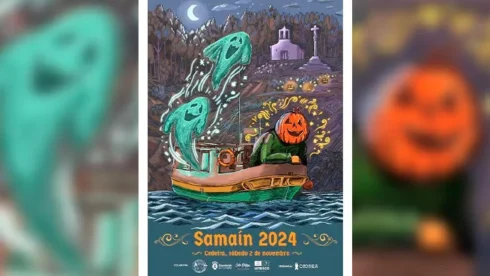 HAIR RAISING: Cedeira’s latest poster for Samain 2024.
HAIR RAISING: Cedeira’s latest poster for Samain 2024. Photo: Amigos de Samain
In Cedeira, villagers compete in pumpkin carving and costume contests, while in Ribadavia, a shadowy procession pays tribute to the ghostly Santa Compaña, and the bravest souls can face their fears in the chilling ‘terror tunnel’.
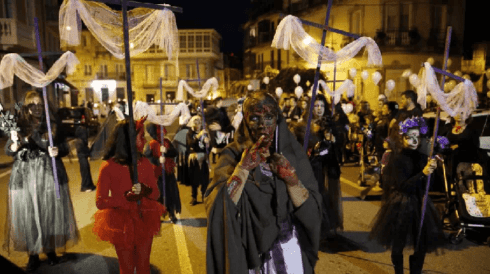 GRUESOME: The revived tradition leads to some grizzly costumes.
GRUESOME: The revived tradition leads to some grizzly costumes. Photo: Tour Galicia
Historic Pontevedra invites visitors to take ghost tours through its Old Town, join costume workshops, and even taste the flavours of the season at themed events with live music.
Loureiro’s work has drawn some criticism, with detractors calling it an extension of American imperialism disguised as Halloween. “The original purpose of reviving Samhain was to stand against Halloween,” he admitted, “but now it’s become a sort of ‘Hallo-haim’ – a mix of Halloween and Samhain.”
READ MORE: Halloween in Spain: Trick or tradition?
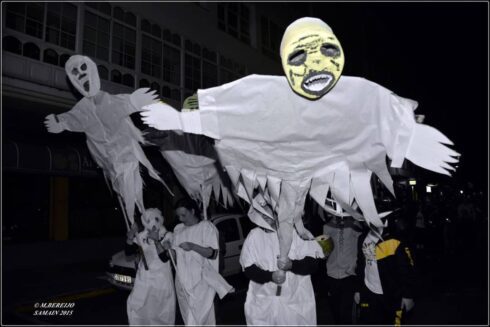 BOO: The ghostly procession at Samain Cedeira
BOO: The ghostly procession at Samain CedeiraPhoto: Amigos de Samain
Samhain is only one of four major Celtic celebrations that haunt the calendar year. It is followed by Imbolc on February 1, marking the return of spring; Beltane on May 1, welcoming summer; and Lughnasa on August 1, celebrating the fruit harvest.
November 1, the day after Samhain, is also All Saints Day, thought to have been established by Pope Gregory IV as a way to honour the dead in response to the ancient Celtic tradition.
Halloween, as we know it today, emerged when Irish immigrants brought their ghostly customs to America during the 1840s potato famine. Its name comes from the Scottish phrase ‘All Hallows’ Eve,’ the night before All Saints Day.
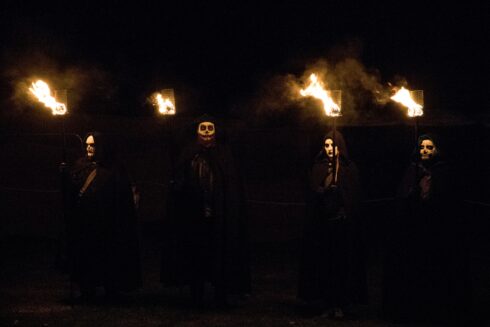 SCOTTISH SAMHAIM: The celtic festival is also celebrated in Scotland.
SCOTTISH SAMHAIM: The celtic festival is also celebrated in Scotland. Photo: Unsplash Robin Canfield
The first Halloween parade was held in Minnesota in 1921, and the tradition quickly spread across the country. But it wasn’t until the 1970s, with the rise of iconic films like John Carpenter’s Halloween (1978), that the spooky celebration returned to Europe, albeit in a form barely recognisable from its ancient origins.
READ MORE: DON’T GET SPOOKED: Five gruesome mysteries remain unsolved in Spain this Halloween
